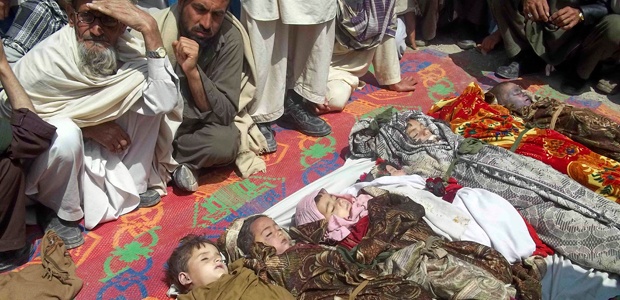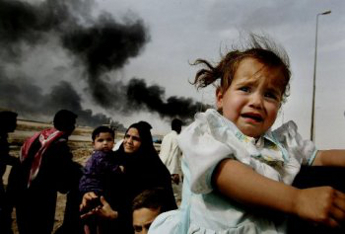
The human rights organization released its annual report on events in the Asia-Pacific region
(January 30, 2020) — Amnesty International’s annual human rights review released on Thursday said that the Afghan civilians continued to pay the price of the ongoing conflict as “justice proved elusive for the victims.”
Citing UN reports, the review stated that civilian casualties remained high throughout 2019, with “July being the deadliest month on record and Afghanistan remaining the deadliest conflict in the world for children.”
The review has found that “hundreds of thousands of Afghans were internally displaced, half a million Afghans were forcibly returned from neighbouring countries, and several thousand more came back from Europe, especially Turkey.”
The report also said that journalists and human rights defenders continue to face intimidation, threats, detention and even death for their work.
“The armed conflict in Afghanistan is not winding down, it is widening, and the people who continue to pay the price are Afghan civilians. Throughout 2019, they were killed, injured, forcibly displaced and subject to other serious human rights violations by both the government and armed groups,” said Omar Waraich, Deputy South Asia Director at Amnesty International.
“In 2020, the world must shake off its indifference to this long-running conflict, and provide the people of Afghanistan with the protection they need and the justice they are owed,” the report said.
The World’s Deadliest Conflict for Children
According to the report, in the first nine months of 2019 more “than 2,400 children were killed or injured in Afghanistan, making it the deadliest conflict in the world for children.”
Also, over the same period, “2,563 people were killed in total and 5,676 injured. The period between July and September was the deadliest on record, with July being the single deadliest month.”
“Most of the attacks were carried out by armed groups, including the Taliban and Daesh. In August, a suicide attack claimed by Daesh killed at least 63 people and wounded more than 200,” the report said.
“In the first six months of the year, pro-government and international forces were responsible for the highest number of civilian deaths,” according to the United Nations Assistance Mission in Afghanistan.
“In December, a US-operated drone strike killed five people, including a mother who had just given birth,” the report claimed.
“There continues to be a shocking disregard for human life from all sides. There are armed groups who have carried out war crimes, and pro-government forces who are responsible for the deaths of the very people they are supposed to be protecting,” said Omar Waraich.
“The Afghan authorities and the international community have a responsibility to ensure that civilians are protected and that the perpetrators of attacks on them are held accountable,” the report said.
Human Rights Defenders under Threat
The report listed cases of human rights defenders in Afghanistan facing threats, intimidation, detention and death:
“In September, the Taliban abducted and killed Abdul Samad Amir of the Afghanistan Independent Human Rights Commission. No one has been held accountable for his murder, which amounted to a war crime,” the report said.
The Amnesty report also mentioned the Logar scandal, a story that the UK’s Guardian broke internationally:
“In December, Afghanistan’s National Directorate for Security, the country’s top intelligence agency, arbitrarily detained Musa Mahmudi and Ehsanullah Hamidi, two human rights defenders who had exposed an alleged paedophile ring operating in Logar province.”
“Faced with threats from both the state and non-state actors, Afghanistan’s human rights defenders are operating in some of the most hazardous conditions anywhere in the world. The Afghan government and the international community have long paid tribute to their bravery, but they must now recognize their achievements, offer them effective support, and ensure that they are respected and protected,” said Omar Waraich.
Forced Returns
According to the report:
“In 2019, the world continued to turn its back on Afghans who had sought sanctuary from the continuing conflict. Neighbouring countries Iran and Pakistan forcibly returned half a million people last year, with more than 476,000 of them being sent back from Iran.”
In Europe:
“European countries continued to forcibly return Afghan asylum-seekers in the hundreds under various agreements made with the Afghan government, despite the grave risks that they would face upon their return to the country.”
In Turkey:
“Turkey forcibly returned at least 19,000 Afghans as of September 2019 after keeping them in poor detention conditions.”
The regional deputy director at Amnesty concludes:
“The conflict in Afghanistan makes it clear that no part of the country is safe for people to be returned to, and yet states continue to do so, in brazen violation of international law, forcing people into harm’s way to face the very dangers they were forced to flee in the first place,” said Omar Waraich.

AIHRC: Civilian Casualties from Afghan Airstrikes Increasing
(January 27, 2020) — The Afghanistan Independent Human Rights Commission (AIHRC) on Monday lashed out at the government for an “increase in civilian casualties” in Afghan forces airstrikes, saying this is not acceptable.
The commission said the security agencies are not bound by rules for protecting civilians during their military operations.
In a recent incident, at least seven civilians — all women and children and members of one family — were killed in an airstrike by government forces in the northern province of Balkh on Saturday, according to residents and relatives of the family.
Figures by the AIHRC show that 485 civilians were killed, and 265 others were wounded, in government forces airstrikes in the past 12 months.
“Even one civilian should not be killed in conflicts between warring parties, but, regretfully, our concerns are growing every day because we see that the (civilian) deaths are increasing every year,” the AIHRC spokesman Naeem Nazari said.
A local rights group meanwhile called for more precision in government forces operations.
“If the civilian casualties are not reduced to zero, they should be at least decreased, and the government should act firmly in this respect,” said Aziz Ahmad Tasal, head of a rights group for the protection of civilians.
“The civilian casualties show the weakness of the government. It weakens the government and it affects people’s trust,” said Atiqullah Amarkhil, a military analyst.
But the Defense Ministry officials see the Taliban as the “main reason” behind civilian casualties in the country.
“Protecting civilians is a priority for the Afghan Defense and Security Forces,” said Rohullah Ahmadzai, a spokesman for the Ministry of Defense. “The Taliban and other groups are the main causes of civilian deaths.”

Over 590 Civilians Killed In Afghanistan In Three Months
(July 15, 2019) — New figures by Afghanistan Independent Human Rights Commission (AIHRC) indicate that 596 civilians were killed and 1,892 others were wounded in clashes between government forces and the Taliban and other attacks by militants in Afghanistan since the beginning of the current solar year which coincides with March 21, 2019.
The CEO of the AIHRC, Musa Mahmoodi, told TOLOnews that 733 of the victims are children who have either been killed or wounded in the conflicts during the period.
“Unfortunately, measures were not taken to reduce the number of civilian casualties,” he said. “In some areas, we saw a sharp rise among vulnerable victims.”
He said the operations in which the casualties happened were carried out by pro-government forces against militants in different parts of the country. But he added that “the Taliban were involved in most part of the casualties”.
The figures, he said, cover the past three months.
A spokesman for the Ministry of Defense, Rohullah Ahmadzai, said the government forces are implementing measures to protect civilians during their operations.
“Narrow mistakes are committed in some cases in which civilians are hurt but we are working on full prevention of harm [to civilians[,” Ahmadzai said.
On July 12, the Human Rights Watch said in a report that Afghan special forces raided a medical clinic in Wardak province on the night of July 8-9, 2019, and killed four civilians.
However, later, the Ministry of Defense said the operation was conducted against militants.
Wardak residents called on the government to protect civilians during their operations.
“The government should consider a change in its plans. Civilians must be protected,” a Maidan Wardak Sayed Amir said.
An MP from Maidan Wardak, Abdul Rahman, said civilian casualties in pro-government forces operations is “a tragedy” and “horrific”.
“The main reason is unconfirmed and unauthentic intelligence reports,” said Mir Haidar Fazli, an MP.
UN Report on Civilian Casualties
The UN Assistance Mission in Afghanistan said in a quarterly report on April 24 that it has documented high levels of harm to civilians but adds that there has been a 23 percent decrease in overall civilian casualties as compared to the same period last year and is the lowest for a first quarter since 2013.
The report says the UN documented 1,773 civilian casualties (581 deaths and 1,192 injured), including 582 child casualties (150 deaths and 432 injured) between January 1 and March 31.
In the first quarter of 2018, UNAMA documented 2,305 civilian casualties (799 deaths and 1,506 injured), including 609 child casualties (176 deaths and 433 injured), the report says.
The overall reduction of civilian casualties was driven by a decrease in civilian casualties by suicide improvised explosive device (IED) attacks, the report says.
UNAMA notes the particularly harsh winter conditions during the first three months of the year, which may have contributed to this trend, the report says.
It is unclear whether the decrease in civilian casualties was influenced by any measures taken by parties to the conflict to better protect civilians, or by the ongoing talks between parties to the conflict, the report mentions.
Posted in accordance with Title 17, Section 107, US Code, for noncommercial, educational purposes.